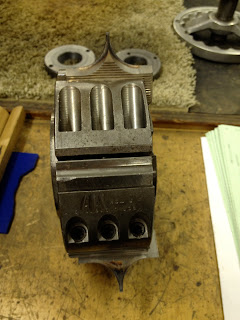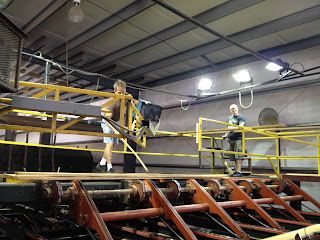Colonial Millwork manufactures hardwood moldings mainly to sell to cabinet and flooring manufacturers. This business uses a very similar process to Wilson Millworks (see post from July 16, 2012). So during our visit today I want to look beyond the overall process to some of the finer details and especially problem-solving techniques.
Problem: An age-old problem for millwork companies was the high ratio of scrap to usable wood (50/50). Boards come to the mills in random widths and lengths. When ripping boards, workers would have to eye the wood and slide it over so that the table saw would cut in such a way to get as many usable pieces as possible.
Solution: Lasers shine onto the loader indicating where the saw blades are located. This allows the worker to be certain they are getting the most out of each board. (There are also some automatic machines that line it up without the manual labor.)
 |
| Notice the red lasers! |
Problem: Lots and lots of sawdust and wood chips!!
Solution: An impressive array of vacuums and pipes run from each machine in the plant outdoors depositing the sawdust and wood chips into trailers which are sold to Hamer Pellet Fuel (see post from July 16, 2012). This not only eliminates the sawdust problem, but allows the company to make money from their "trash!"
Problem: Quality control
Solution: In addition to making a plastic cutout of the profile and the knife, Colonial also cuts out a plastic guide that can slide across the finished product to ensure each piece is uniform. They can also send these to the customer if they desire "proof."
Problem: Small pieces need to be cut from larger pieces without wasting wood. (Example: Quarter round)
Solution: A knife is created that cuts the blank in the center producing two identical pieces of product.
 |
| This is a model that shows two pieces of quarter round cut from the same piece of wood. |
Problem: Struggling economy means less demand for products.
Solution: Think outside the box and open up to new, yet similar products. For example, Colonial now produces parts for picture framing companies as well as wine and spice racks, and even a huge ceiling project for Disney World (see pictures below)!
 |
| Black felt is manually stapled behind carefully spaced pieces of wood so Disney visitors cannot see through to the rafters. |
 |
| Disney's finished project ready to ship. |
Application:
Whether you are in school trying to figure out a complicated word problem or in the "real-world" and notice inefficiency, don't let problems stump you. Think of them as puzzles or fun challenges. Often it takes several (sometime MANY) attempts to find a good solution. Remember Thomas Edison once said, "I have not failed. I've just found 10,000 ways that won't work." He only had to find ONE way that did work! Always be part of the solution, not part of the problem!
















































